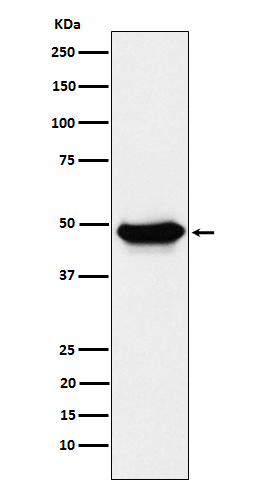Anti-ENTPD5 Rabbit Monoclonal Antibody
- SPECIFICATION
- CITATIONS
- PROTOCOLS
- BACKGROUND

Application
| WB |
|---|---|
| Primary Accession | O75356 |
| Host | Rabbit |
| Isotype | IgG |
| Reactivity | Rat, Human, Mouse |
| Clonality | Monoclonal |
| Format | Liquid |
| Description | Anti-ENTPD5 Rabbit Monoclonal Antibody . Tested in WB application. This antibody reacts with Human, Mouse, Rat. |
| Gene ID | 957 |
|---|---|
| Other Names | Nucleoside diphosphate phosphatase ENTPD5, 3.6.1.6, CD39 antigen-like 4, ER-UDPase, Ectonucleoside triphosphate diphosphohydrolase 5 {ECO:0000312|HGNC:HGNC:3367}, NTPDase 5, Guanosine-diphosphatase ENTPD5, GDPase ENTPD5, Inosine diphosphate phosphatase ENTPD5, Nucleoside diphosphatase, Uridine-diphosphatase ENTPD5, UDPase ENTPD5, ENTPD5 (HGNC:3367) |
| Calculated MW | 47 kDa |
| Application Details | WB 1:500-1:2000 |
| Contents | Rabbit IgG in phosphate buffered saline, pH 7.4, 150mM NaCl, 0.02% sodium azide and 50% glycerol, 0.4-0.5mg/ml BSA. |
| Clone Names | Clone: 21E75 |
| Immunogen | A synthesized peptide derived from human ENTPD5 |
| Purification | Affinity-chromatography |
| Storage | Store at -20°C for one year. For short term storage and frequent use, store at 4°C for up to one month. Avoid repeated freeze-thaw cycles. |
| Name | ENTPD5 (HGNC:3367) |
|---|---|
| Function | Hydrolyzes nucleoside diphosphates with a preference for GDP, IDP and UDP compared to ADP and CDP (PubMed:10400613, PubMed:15698960). In the lumen of the endoplasmic reticulum, hydrolyzes UDP that acts as an end-product feedback inhibitor of the UDP-Glc:glycoprotein glucosyltransferases. UMP can be transported back by an UDP-sugar antiporter to the cytosol where it is consumed to regenerate UDP- glucose. Therefore, it positively regulates protein reglucosylation by clearing UDP from the ER lumen and by promoting the regeneration of UDP-glucose. Protein reglucosylation is essential to proper glycoprotein folding and quality control in the ER (By similarity). |
| Cellular Location | Endoplasmic reticulum {ECO:0000250|UniProtKB:Q9WUZ9}. Secreted |
| Tissue Location | Expressed in adult liver, kidney, prostate, testis and colon. Much weaker expression in other tissues |

Thousands of laboratories across the world have published research that depended on the performance of antibodies from Abcepta to advance their research. Check out links to articles that cite our products in major peer-reviewed journals, organized by research category.
info@abcepta.com, and receive a free "I Love Antibodies" mug.
Provided below are standard protocols that you may find useful for product applications.
If you have used an Abcepta product and would like to share how it has performed, please click on the "Submit Review" button and provide the requested information. Our staff will examine and post your review and contact you if needed.
If you have any additional inquiries please email technical services at tech@abcepta.com.













 Foundational characteristics of cancer include proliferation, angiogenesis, migration, evasion of apoptosis, and cellular immortality. Find key markers for these cellular processes and antibodies to detect them.
Foundational characteristics of cancer include proliferation, angiogenesis, migration, evasion of apoptosis, and cellular immortality. Find key markers for these cellular processes and antibodies to detect them. The SUMOplot™ Analysis Program predicts and scores sumoylation sites in your protein. SUMOylation is a post-translational modification involved in various cellular processes, such as nuclear-cytosolic transport, transcriptional regulation, apoptosis, protein stability, response to stress, and progression through the cell cycle.
The SUMOplot™ Analysis Program predicts and scores sumoylation sites in your protein. SUMOylation is a post-translational modification involved in various cellular processes, such as nuclear-cytosolic transport, transcriptional regulation, apoptosis, protein stability, response to stress, and progression through the cell cycle. The Autophagy Receptor Motif Plotter predicts and scores autophagy receptor binding sites in your protein. Identifying proteins connected to this pathway is critical to understanding the role of autophagy in physiological as well as pathological processes such as development, differentiation, neurodegenerative diseases, stress, infection, and cancer.
The Autophagy Receptor Motif Plotter predicts and scores autophagy receptor binding sites in your protein. Identifying proteins connected to this pathway is critical to understanding the role of autophagy in physiological as well as pathological processes such as development, differentiation, neurodegenerative diseases, stress, infection, and cancer.


